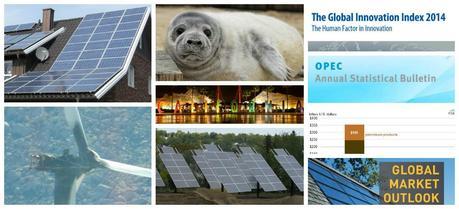
Unconventional oil and natural gas extraction techniques are driving a revolution in the traditional energy sector, while solar and wind energy continue to gain market share. One report finds European countries to be the world’s most innovative and another report shows that California leads the U.S. in clean tech for the fifth consecutive year. We have collected all these stories and more of the most important energy news of the past month conveniently in one place for you to read.
Oil and Natural Gas
Russia’s Revenue Comes Mostly From Oil, Natural Gas
According to the EIA, Russia is a major exporter of crude oil, petroleum products, and natural gas. Sales of these fuels accounted for 68% of Russia’s total export revenues in 2013, based on data from Russia’s Federal Customs Service. Oil and natural gas activities make up a large portion of Russia’s federal budget. According to the Ministry of Finance, 50% of Russia’s federal budget revenue in 2013 came from mineral extraction taxes and export customs duties on oil and natural gas.
SEE ALSO: [Special Edition] June, 2014: Energy Stats, Trends and Perspectives
Oil Exports Play Growing Role in Reducing U.S. Trade Deficit
Since the mid-1970s, the United States has run a deficit in merchandise trade, meaning that payments for imports exceeded receipts for exports. This large and growing deficit on the merchandise trade balance reached a maximum of $883 billion in the second quarter of 2008. Since 2009, exports of petroleum and petroleum products have played a growing role in reducing the overall merchandise trade deficit.
OPEC Releases 49th Online Edition of Its Annual Statistical Bulletin
The Annual Statistical Bulletin provides detailed and comprehensive time-series data on many different aspects of the global petroleum industry, including imports and exports, as well as exploration, production and transportation activities. The publication contains key statistical data on oil and natural gas activities in each of OPEC’s 12 Member Countries and provides valuable industry data for various other countries with detailed classifications mainly by geographical region.
Solar Energy
“Global Market Outlook for Photovoltaics 2014-2018” Report Published
The European Photovoltaic Industry Association has just published its “Global Market Outlook for Photovoltaics 2014-2018” report. The report includes solar photovoltaic market figures for 2013 and a forecast for the 2014-2018 period. According to the report, the PV market progressed remarkably in 2013, with at least 38.4 GW of newly-installed solar photovoltaic capacity worldwide and a global cumulative installed capacity of 138.9 GW.
Most Solar Panels Are Reliable
A new report, the PV Module Reliability Scorecard 2014, by GTM Research and PV Evolution Labs, now DNV GL, found that PV manufacturer’s solar panels performed relatively well across all metrics. However, “module reliability is not necessarily a consistent quality,” wrote report author, GTM Research solar analyst Jade Jones. “Of all vendors analyzed, only one company consistently ranked within the Performance Leaders group for all test regimens.”
Solar PV Is Leading World in Distributed Power Market
A new study by GlobalData found that solar photovoltaics (PVs) are already leading the world in the distributed power market consisting of 48% of the total distributed power capacity installed last year. In addition, the amount of annually installed distributed generation is slate to increase from 190 GW in 2013 to roughly 389 GW in 2019.
The most popular posts in July, 2014
1. Study: It Is Feasible to Power California With Renewables
2. Bacteria Produce Unique Battery Electrode Material
3. New Magnetic Materials Make Electric Motors More Efficient
4. Carbon-Based Catalyst for Batteries, Fuel Cells Developed
5. Roadside Noise Barrier to Generate Solar Energy
Wind Energy
Wind Turbines Can Benefit Wildlife
Scientists at the University of St Andrews have discovered that offshore pipelines and wind turbines can provide new feeding opportunities for the wildlife population in the area. The study, published in the journal Current Biology, found that some seals appeared to deliberately seek out and forage close to these structures.
Scientists Worry About Wind Turbines Catching Fire
Scientists at the Imperial College London suggest that incidents of wind turbines catching fire are a big problem that is not currently being fully reported. The team found that ten times more fires are happening than are being reported. Instead of an average of 11.7 fires each year, which is what is reported publicly, the researchers estimate that more than 117 separate fires are breaking out in turbines annually.
European Offshore Wind Industry Statistics Published
According to the EWEA report, on the first six months of 2014, Europe fully grid connected 224 offshore wind turbines in 16 commercial wind farms and one offshore demonstration site with a combined capacity totaling 781 MW. There are also 310 wind turbines awaiting grid connection.
Innovation and Clean Technology
Global Innovation Index 2014 Ranks Countries by Innovation
The Global Innovation Index 2014, co-authored by Samuel Curtis Johnson Graduate School of Management Dean Soumitra Dutta, was released in Sydney, Australia, July 18 at the B20 international business summit. The report shows European countries as the world’s most innovative and finds encouraging signs from sub-Saharan Africa. According to the report, the United States is the world’s 6th most innovative economy.
2014 U.S. Clean Tech Leadership Index Ranks U.S. States by Clean-Tech Activities
Clean Edge, an American research and advisory firm, has released its 2014 U.S. Clean Tech Leadership Index, which tracks the clean-tech activities of all 50 states and the 50 largest metro areas in the U.S. According to Clean Edge, 11 states now generate more than 10% of their electricity from non-hydro renewable energy sources, with two—Iowa and South Dakota—exceeding 25%. Solar installations climbed more than 40% percent year-over-year in the U.S., while registrations of all-electric vehicles doubled between the 2013 and 2014 indexes, to approximately 200,000 nationwide.
This month in photos: July 2014

Charging electric cars by induction is still a distant vision. By installing the charging system at the front of the vehicle, scientists have found a new efficient and cost-effective approach. (Credit: Fraunhofer IISB)

The phosphorescent LEDs can reveal the presence of water under backlight. Water causes polymers to break in the LEDs, changing from phosphorescent light (green) to fluorescent light (blue). (Сredit: Joseph Xu / University of Michigan)

NIST’s Jodie Pope and her team have developed this prototype field test standard to test the accuracy of hydrogen fuel dispensers. (Credit: Suplee / NIST)

Cascade systems are implemented and validated in two major European airports from December/April 2014 to March 2015:
Milano Malpensa (on the photo) and Roma Fiumicino. (Credit: Flickr @ mmphotography.it https://www.flickr.com/photos/grantuking/)

The hydroelectric plants in the Columbia River basin in the Pacific Northwest generate 22,000 MW in output. In the photo: a dam wall in the many-branched dam system. (Credit: Fraunhofer IOSB)

An energy efficient cooking pan. (Credit: Lakeland)

